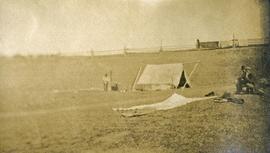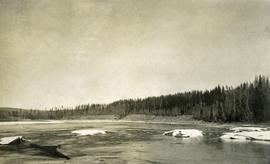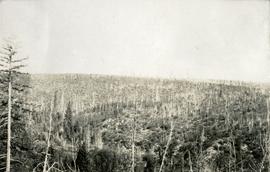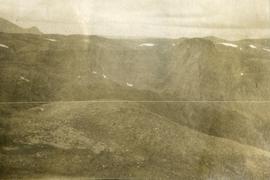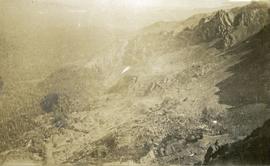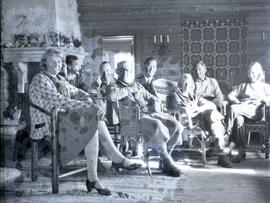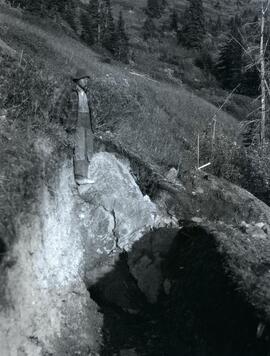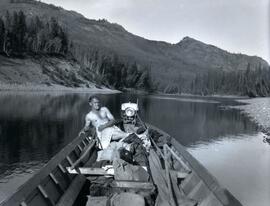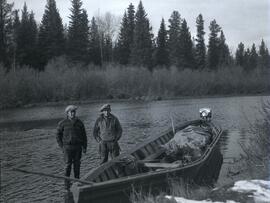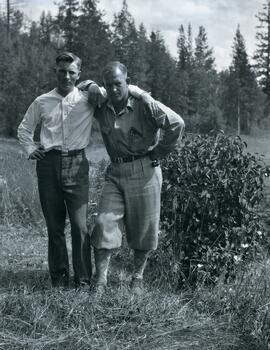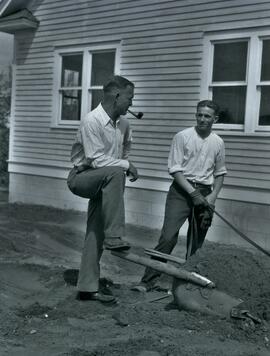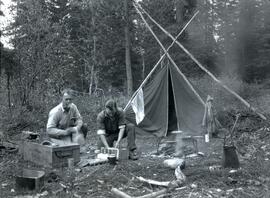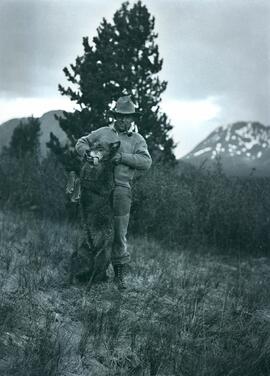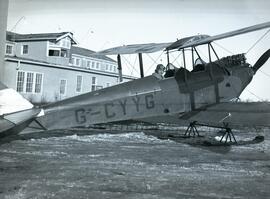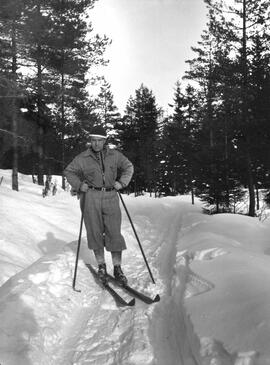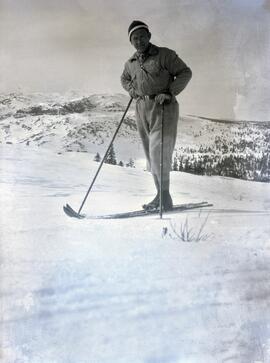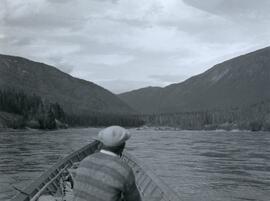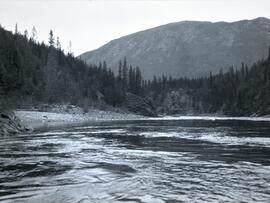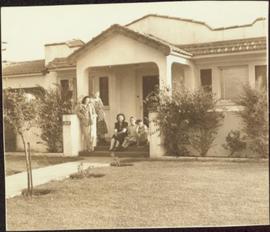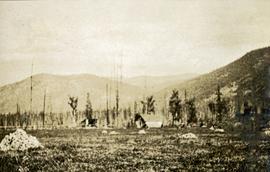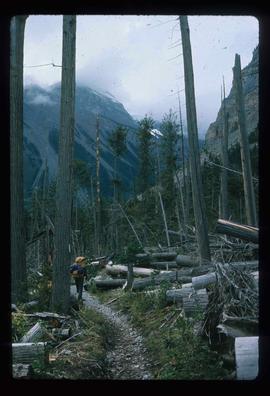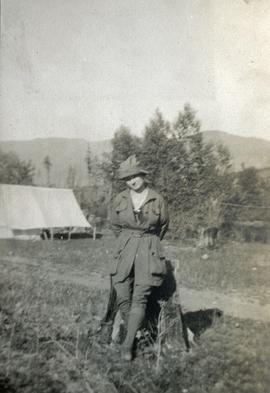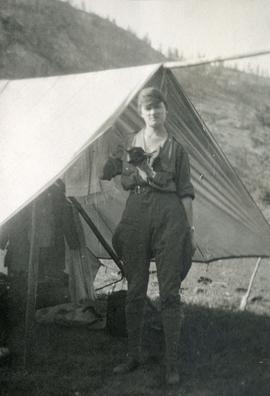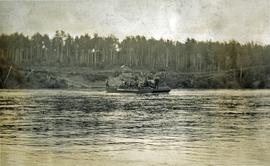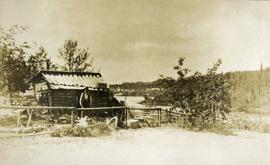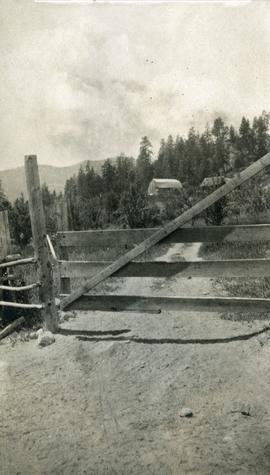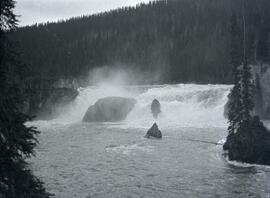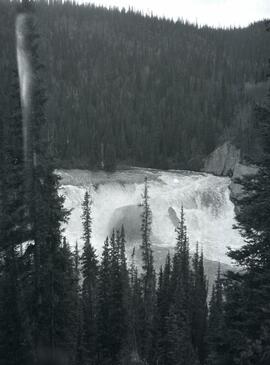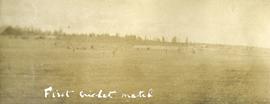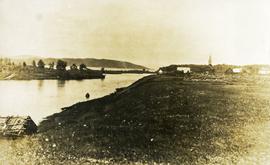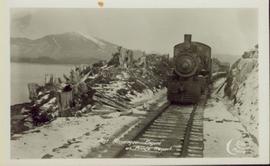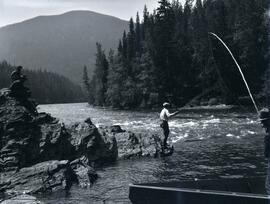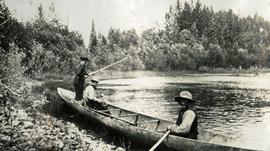Photograph depicts a tarp spread out on the grass, two men sit nearby the tarp. There is a canvas tent in the background with a man standing beside it. Behind the tent is a low hill with a fence bordering the top of the hill. There are blankets drying on the fence.
File consists of notes and reproductions relating to the Duke of Sutherland. Also includes photographs depicting the area of White's Landing in Strathnaver (2010).
Subseries includes material collected by Kent Sedgwick regarding the Duke of Sutherland. The Duke of Sutherland is a title in the Peerage of the United Kingdom. The fourth Duke of Sutherland was Cromartie Sutherland-Leveson-Gower who lived from 1851 to 27 June 1913. Toward the end of his life, the 4th Duke began moving his wealth and life to Canada. The Duke owned land across British Columbia and Alberta and contributed to various settlements, including Strathnaver, BC; Windermere, BC; Brooks, AB; and Clyde, AB. The Duke of Sutherland owned the Sutherland Land Company, creating and selling plots in BC and Alberta. He also worked closely with the Canadian Pacific Railway to support immigration and settlement of the area.
A collection of photographs of the early exploration exhibitions in the asbestos mountains area.
Photograph depicts open river waters with some patches of ice on the river shore. There are riverbanks and trees in the background.
Photograph depicts a view from a high ridge looking over vast forest.
Photograph depicts a rocky, mountain slope.
Photograph depicts a rocky, mountain slope.
Photograph depicts five men and three women seated in a semi-circle inside a wooden cabin in Gola, Norway.
Photograph depicts a man (Ed Short) standing on a boulder in front of a hillside covered with grass and trees.
File consists of eight newspaper clippings, seven of which are a series of articles on the findings of the Oxford University Ellesmere Land Expedition, with the eighth being a photograph of the Expedition’s winter quarters in Etah, Greenland. Five of the articles were written by the expedition leader, Mr. Noel Humphreys and the other two were written by members of the Expedition, Mr. Moore and Mr. Haig-Thomas. The articles were originally published in the “Times” of London but the clippings appear to be from the “New Zealand Herald”.
Humphreys, NoelPhotograph depicts Emil Bronlund at the back of a wooden motor boat resting after a swim in the Omineca River, located near Germansen Landing.
Photoraph depicts two men, Emil Bronlund and Clarence Waldof, standing beside a long motorboat at the edge of Crooked River in front of a forested landscape.
Photograph depicts two men, Emil Bronlund and Clarence Waldof, posing for a photograph at a farm in Prince George.
Photograph depicts two men (Emil Bronlund and Henry Waldo) in conversation while at work clearing dirt in front of a house in Prince George.
Photograph depicts Emil Bronlund and another man kneeling at camp with a tent and cooking fire. The camp is located at Little Canyon near the upper Omineca River.
Photograph depicts a man (Emil Bronlund) holding up a dead wolf standing in a grass covered landscape in front of a tree with a mountain in the far-right background.
Photograph depicts Emil Bronlund in the second seat of G-CYYG De Havilland D.H. 60 Moth aircraft at the Edmonton Airport. This plane was operated by the Edmonton Aero Club.
Photograph depicts a man (Emil Bronlund) standing on skis in front of a ski trail that leads through a snow-covered forest.
Emil Bronlund was in 1927 hired by Consolidated Mining and Smelting Ltd. (later known as Cominco) to take on the company's mining exploration in northern British Columbia, a position he held for almost 25 years. Bronlund had a Leica camera and took photographs during his exploratory trips.
This album of Bronlund's photographic negatives from 1930 to 1932 includes photographs of the following trips:
- Trip to Osilinka River and Omineca River, July 1930
- Copper Mountain on Duck Creek, July 1930
- Wedge Creek, Sept. 1930
- Finlay River, Finlay Forks, Parsnip River, and Crooked River, Oct. 1930
- Prince George, Aug. 1930
- Gola, Norway, Apr. 1931
- Emil Bronlund and Frank Swannell survey crews at Thutade Lake, June 1931 and Sept. 1931
- Cairn mining claim exploration for Consolidated Mining and Smelting Ltd., June-July 1931
- Brothers Lake, Bronlund Peak, and Fredricksen Lake, July 1932
- Sustut Lake, Sept.-Oct 1931
- McLeod River trip, Mar.-Apr. 1932
Photoraph depicts a man (Emil Bronlund) skiing in Gola, Noway with a snow-capped mountain range visible in the background.
File consists of notes, clippings, and reproductions relating to encouraging settlement and immigration to Prince George. Includes material on Dutch settlement in Prince George; the Hornby Plan, a 1933 settlement plan by the Canadian National Railway to develop communities and stimulate business for the railway, particularly in Prince George; promoting Prince George for settlers; reserved land for veterans; and auction of lands to cover delinquent taxes in British Columbia.
Photograph depicts a man siting in a wooden boat on the Omineca River leading to the entrance of Little Canyon toward a forested shoreline.
Photograph depicts the rocky shoreline and forest environment at the entrance to Little Canyon viewed from the Omineca River.
Photographs within this file pertain to the early exploration of northern British Columbia.
This BC Provincial Archives photograph reproduction depicts five men carving a canoe close to Finlay River on September 18, 1913.
Façade of the Arch-cathedral in St. John's in Warsaw, Poland.
Photograph taken during European Sports Tour with Team Canada.
Three woman, young girl, and young boy stand and sit in entry way of house with tiled roof. Sidewalk, front lawn, and hedges in foreground. Photograph believed to have been taken in Los Angeles, California.
Five woman and one young girl pose on grass in front of palm trees.
Photograph depicts a field in the foreground, trees and mountains in the distance.
File consists of notes, clippings, and reproductions relating to Father Adrien Morice. Father Adrien Morice was a missionary and was ordained as a priest who came to British Columbia in 1880 to complete his ecclesiastical studies. After completing his schooling he was signed to the Williams Lake Mission where he worked closely with the Chilcotin peoples, learning their language and ministering. He continued to learn Chinook before moving to work at Stuart Lake with the Na'Kaztl'Tenneh Band in 1885, working with four divisions of the Carrier Tribes, the Alexandria, Quesnel, Blackwater, and Lhuskuz. Morice continued to use the Cree language and eventually published a monthly newspaper between 1881 and 1884 called "Tsettes Nahivelnik" (meaning "storyteller") using the Cree language. File primarily consists of handwritten notes by Kent Sedgwick regarding Father Adrien Morice and his work.
Image depicts a large number of felled trees, and an unknown individual standing on the path.
Photograph depicts a young female standing beside a stump dressed in outdoor clothing, a tent is in the background.
Photograph depicts a young female standing beside an open tent in outdoor clothing (possibly a crew member?).
Photograph depicts a scow loaded with three or more pack horses with men attending. The scow is crossing the river, guided by a cable. There is one building, and forest in the background.
Photograph depicts a man standing near a rough log shed. A fence line leads toward a lake. A small settlement and treed hills in the background.
Photograph depicts a man standing near a fenced garden plot is nearby. A body of water, a small settlement and treed hills in the background.
Photograph depicts rolling fields with a newly ploughed area in the center of the image with forest in the background.
Photograph depicts a ranch style gate looking beyond to a road and buildings.
Photograph depicts a wide waterfall (Finlay Falls) located above Thutade Lake with a forest in the background.
Photograph depicts a wide waterfall (Finlay Falls) seen through a tree covered landscape.
Photograph depicts a steam paddle wheeler anchored near the shore of a river. A walk plank joins the steamship to the rocky river shore.
Photograph depicts several men sitting on a rough hewn table, under a tarp. Eating utensils cover the table, towels are drying on the ropes that hold the tarp. There is a canvas tent erected on the right.
Photograph depicts several people in a large field. There are buildings and trees in the background.
Photograph depicts a cluster of buildings near Fraser Lake. A fence and grasses in the foreground. Original photo title: "Indian Village at Fraser Lake." First Nations communities with territories overlapping Fraser Lake include Nadleh Whut'en and Stellat'en Nations.
Head on shot of steam engine traveling through a pass with mountains in the background. Handwritten annotation in pen on verso reads: "First Passenger Engine to reach Prince Rupert." Annotation on recto reads: "First Passenger Engine at Prince Rupert." Photographer' stamp in bottom right corner of recto reads : "Allen Photo."
Photograph depicts men fishing off a rocky point between the Omineca and Osilinka Rivers.
Photograph depicts two men sitting in a large, possibly, cottonwood canoe. One man stands while holding a fishing pole. This is near the edge of a small river or large creek.
Photograph depicts five long canoes with several men attending. The canoes are traveling through a narrow strip of open water. The majority of the river is covered in ice. Forested trees are on the far river shore.
Photograph depicts five long canoes with several men attending. The canoes are traveling through a narrow strip of open water. The majority of the river is covered in ice. Forested trees are on the far river shore.
